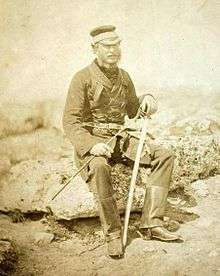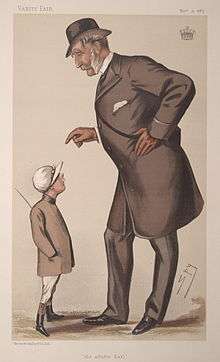Francis Fane, 12th Earl of Westmorland
| The Earl of Westmorland CB, DL | |
|---|---|
 Lord Westmorland in 1855. Albumen print by Roger Fenton | |
| Born | 19 November 1825 |
| Died | 3 August 1891 (aged 65) |
| Allegiance | British |
| Service/branch | Army |
| Rank | Colonel |
| Battles/wars | Battle of Gujrat; Battle of Alma |
| Awards | Crimea Medal; Légion d'honneur; Order of Medjidié |
| Spouse(s) | Adelaide Curzon-Howe |
Colonel Francis William Henry Fane, 12th Earl of Westmorland CB, DL (19 November 1825 – 3 August 1891), styled Lord Burghersh between 1851 and 1859, was a British Army Officer and racehorse owner.
Background and education
Fane was the fourth but eldest surviving son of John Fane, 11th Earl of Westmorland, by Lady Priscilla Anne, daughter of William Wellesley-Pole, 3rd Earl of Mornington. He was educated at Westminster and the Royal Military College, Sandhurst.[1]
Military career

Lord Westmorland campaigned in the First Anglo-Sikh War and the Battle of Gujrat during the second war. He also participated in the Crimean War, being awarded the Medjidie and the Légion d'honneur on 30 April 1857, and appointed a Companion of the Order of the Bath (CB) on 10 July 1855.[1]
On 1 August 1848 he was promoted captain and made aide-de-camp to Viscount Hardinge, the governor-general of India. He served under Lord Gough in the following winter, received a medal for bravery at the battle of Gujerat on 21 February 1849, and obtained his majority on 7 June 1849. On the conclusion of the Sikh war he returned to England and exchanged into the Coldstream Guards. On the outbreak of the Crimean war, he went out as aide-de-camp to Lord Raglan (his uncle by marriage), and served with distinction at the Battle of Alma (20 September 1854), bringing home Raglan's despatches. He was appointed brevet lieutenant-colonel on the day of the battle, and lieutenant-colonel on 12 December following. Subsequently, he was present at Raglan's death on 28 June 1855 ; he received the Crimea Medal and the fifth-class Order of Medjidié on 2 March 1858, and in 1856 became aide-de-camp to the Duke of Cambridge.[2]
Following the death of his three brothers, he became heir to the earldom of Westmorland. In 1859 he succeeded his father and, the following year, retired from the army ranked as a Colonel.
Horse racing
From this time he became a member of the Jockey Club and a racehorse owner, colours green with white braid. His horses never won any of the Classics and he was known to place heavy stakes.[1] In 1866 he sold the family portraits by Joshua Reynolds, Mr Fane and Lord Burghersh.[3] Eventually his finances forced him to sell his horses and, instead, he managed Lord Hartington's stable.[1]
He died at 34 Brook Street on 3 August 1891, and was buried at Apethorpe, Northamptonshire.[2]
Family

Lord Westmorland married Lady Adelaide, daughter of Richard Curzon-Howe, 1st Earl Howe, in 1857. The Countess of Westmorland died in March 1903. They had four children:
- Lady Grace Adelaide Fane (died 13 June 1933), married William Denison, 2nd Earl of Londesborough and had issue
- Lady Margaret Mary Fane (died 22 November 1949), married Capt. John Edmund Philip Spicer
- George Neville John Fane, Lord Burghersh (3 September 1858 – 31 July 1860)
- Anthony Fane, 13th Earl of Westmorland (1859–1922)
He was succeeded by his second but only surviving son, Anthony,[2] who was forced to sell the family seat, Apethorpe Hall in 1904. The house had been in the family for 300 years.
References
- Attribution
![]() This article incorporates text from a publication now in the public domain: Pollard, Albert Frederick (1901). "Fane, Francis William Henry". In Sidney Lee. Dictionary of National Biography, 1901 supplement. London: Smith, Elder & Co.
This article incorporates text from a publication now in the public domain: Pollard, Albert Frederick (1901). "Fane, Francis William Henry". In Sidney Lee. Dictionary of National Biography, 1901 supplement. London: Smith, Elder & Co.
External links
| Wikimedia Commons has media related to Francis Fane, 12th Earl of Westmorland. |
| Peerage of England | ||
|---|---|---|
| Preceded by John Fane |
Earl of Westmorland 1859–1891 |
Succeeded by Anthony Mildmay Julian Fane |
